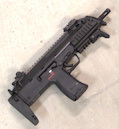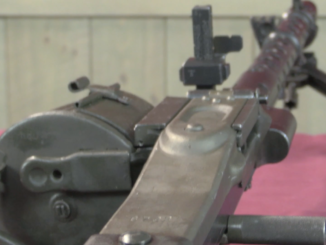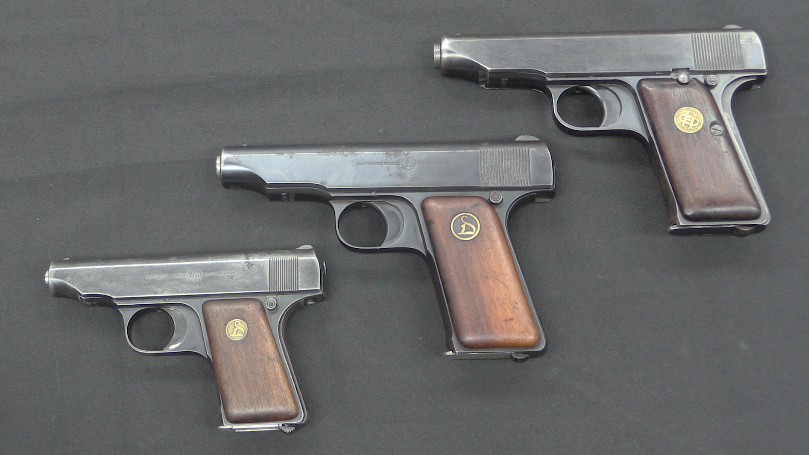The initial patent for what would become the Bergmann pistols was actually a delayed blowback mechanism, and it was quickly revised to simple blowback by Louis Schmeisser. The first actual production pistols, designated the No.1, used this plain blowback system.
This initial Bergmann-Schmeisser design’s notable features include loading via 5-round Mannlicher type clip, a recoil spring located under the barrel, and a unique birds-head style grip. Note also the bolt guide rail on the left side of the pistol.
Very few of the No.1 pistols would be made before a number of significant changes were made, resulting in the 1896 pattern, including the No.2, No.3, and No.4 pistols.




I wonder if the integrated cleaning rod could possible have been moved to the right side of the gun for the benefit of left-handers? Personally I think it probably should have had two cleaning rods, one on each side, not just for a more ambidextrous gun, but so that there would be a backup rod available if the gunman should happen to drop the cleaning rod during a highly inappropriate time …
With rimless/grooveless cartridges and no extractor, I can only wonder how long it must have taken to clear a dud round: pull out cleaning rod from left side of gun, ram down muzzle and poke dud out breech end. Hopefully Bergmann pistoliers would have practiced this life-saving skill regularly to keep their recovery times to a minimum …
… or better yet, just ditch the pistol and get a plain old reliable revolver, and wait a few years until pistol design would become a little more than just half-baked.
Agreed. The problem with blowback pistols without any form of manual extraction is stuck cases. One needs casings designed for manual extraction without ramming a rod down the barrel unless there’s no other way. That aside, revolvers are generally less likely to fail on the draw. And it is generally a bad idea to use revolver holding techniques for semi automatic handguns unless there is enough cycling energy to load the chamber while the user’s arm dampens recoil. Did I mess up?
“fail on the draw”
What that mean?
I always thought draw = end or leave (a contest) tied or undecided but this make no sense here.
I mean failing to fire or failing to continue to operate upon removing the weapon from its holster and then pulling the trigger. If a Bergmann pistol fails to extract a spent cartridge case upon firing in defense, the user may have to use the gun as a bludgeon. Afterwards the user, of alive, will have to field strip the gun just to be sure it won’t jam again…
I don’t know what the word “draw” would be in Russian, but in Spanish it appears to translate to “desenfunda” (literally, “unbuckle”) according to this Spanish-translated publicity poster of an old Hollywood film named “Draw!”.
http://www.imdb.com/title/tt0087174/
During the period of ‘classic’ Hollywood Westerns, the word “draw” seemed to be obligitory dialogue in every film whenever unfriendly gunslingers meet and perform a rather predictable street ritual (i.e., shooting at each other) in the middle of Main Street in every Old West town in every Hollywood film.
I’ve never watched a Spanish-language Western, but it would just seem to me that anyone who yells “desenfunda” in a hair-trigger dual would likely get shot before he could even finish pronouncing the word.
“word “draw” would be in Russian”
Ah, that would be выхватывание
http://www.zakon-grif.ru/shot/articles/view/80-0.htm
Weren’t many of the Spaghetti Westerns produced by Italians actually filmed in Spain, because Italy does not have suitably arid terrain? Not that they spoke Spanish in those films. They did speak Italian if that was the actor’s native language, which was then dubbed in English for English speaking markets.
“I’m givin’ you one second to draw a gun!” -Yosemite Sam
https://www.youtube.com/watch?v=nF7s8bTpV-Y
“(…)no extractor(…)pistol design would become a little more than just half-baked(…)”
For other extractor-less automatic pistol see Le Français .25 pocket automatic pistol:
http://modernfirearms.net/handguns/hg/fr/le-francais-e.html
It was developed in 1913 and its cursory description is typical for 1910s vest pocket automatic pistol: blow-back design firing 6,35 mm Browning (.25 Auto), however it is unusual in that it has no extractor – gas pressure is used to eject spent case, which mean faulty cartridge mean problem. This automatic pistol is also top-break design (see 4th photo from top) – this feature is also rather unusual, but more common than lack of extractor (example of top-break automatic pistol: Steyr Kipplauf Pistole) and has no way to manually cycle action, which mean that you have place magazine in weapon and separately load one round directly into chamber.
Notice that despite that oddities this automatic pistol was produced until 1968, so it must be successful marketing-wise – apparently lack of extractor was acceptable for users.
(There was also up-scaled version firing 7,65 mm Browning / .32 Auto featuring extractor and possibility of manual cycling but it was manufactured since 1950)
Addendum:
According to http://unblinkingeye.com/Guns/Francais/francais.html Le Français .25 pocket automatic pistol barrel would open automatically after magazine removal and can be closed only when magazine is loaded. For me it looks like solution for problem of forgotten cartridge in chamber popular in 1900s – users assumed that after magazine is remove from automatic pistol it is safe, that is will not fire. For many designs it is not true and this lead to several accidents, so various solution were proposed, which prevent automatic pistol from firing if there is no magazine (magazine disconnect), however in most cases were they were not as radical as in Le Français.
Beretta still makes pocket pistols with a tip-up barrel. This system is does not require he user to rack the slide, which makes it suitable for people with low hand strength, for example elderly women.
Yes. I have and older model 950 and it works like a charm. At least in my .25 ACP version.
“This system is does not require he user to rack the slide, which makes it suitable for people with low hand strength, for example elderly women.”
Other advantage is that access for barrel cleaning is probably as easy as can be.
Some automatic pistol models have hinge as part of disassembly, for example ČZ vz. 38 (chambered for 9x17mm Browning cartridge, produced in occupied Czechoslovakia) or ÖWA vest-pocket .25 automatic pistol as can be seen here:
https://www.youtube.com/watch?v=yEt_ubsET2U
“Beretta still makes pocket pistols with a tip-up barrel.”
Other automatic pistols with tip-up barrel enabling manual loading:
Reising .22 automatic pistol (I don’t know its model number or name) see photos here: http://americanhandgunner.com/exclusive-web-extra-the-reising-22-semi-auto-pistol/
Taurus Model 22 (also known as Taurus PT22) – .22 rim-fire
Taurus Model 25 (also known as Taurus PT25) – .25 Auto
Jo.Lo.Ar automatic pistol and its predecessor known as “Sharp-Shooter”
The odd thing I have never understood about the Bergmanns and some other early semiauto pistols is that they have the same or even smaller capacity than the typical revolvers of the day, and they aren’t even very small or very compact. Thinner maybe than revolvers, but not small overall. Reloading with the clip is probably faster than reloading a revolver without a speed loader (which were not commonly used), but still it seems like a less practical weapon. After all, reliability was not up to revolver standards, either. Did people buy these for just the novelty’s sake?
Not trying to lecture anyone here, but with non-existent extractor, the cycle gets little too tricky over normal state. The brass expands and holds onto chamber for couple of tenses of millisecond before it rebounds. At the end of it chamber still has to posses sufficient pressure to cycle action. Chancy, isn’t it… but this is essence of blowback.
In case of Bergmann, they had with their own proprietary cartridge situation little more under their thumb (such as brass hardness and powder burning characteristic), but still…. it was barely doable.
The principle of blowback was sound but the approach was not. I would think that a modified revolver cartridge would have been a better start for prototype designs. The tooling for producing rimless rifle cartridges already existed in 1889 if we take 7.65×53 Argentine and 7×57 Mauser as good examples of extremely popular mass-produced/mass-exported military grade rimless ammunition, so why not use the same kind of tooling to make rimless pistol cartridges? Think of all the trouble and almost needless losses Bergmann and Schmeisser could have saved themselves had they thought about taking a much simpler approach than “make proprietary ammunition right off the bat and hope people buy it up in bulk after we demonstrate rapid fire and rapid reload while the revolvers are struggling to get reloaded in a dark alley scuffle.” Did I mess up the ideas?
The choice of a “proprietary” cartridge was quite understandable. There were practically no established rimless centerfire cartridges for pistol use in the early 1890s. Even most rimmed revolver cartridges we think of being old were either quite new or not even developed yet. For example even the .38 Special and .32 S&W Long did not exist yet.
It can be said that the choice to not to include an extractor in the design was unfortunate in retrospect, but the need for a extractor on a blowback action pistol was not well understood. Only practical experience would show that it was needed.
“Only practical experience would show that it was needed.”
I want to add that making extractor groove costs, so it would make cartridge more expensive. So it should be understandable that they want avoid cost of something which maybe will be used, but rather not.
“Even most rimmed revolver cartridges we think of being old were either quite new or not even developed yet. For example even the .38 Special and .32 S&W Long did not exist yet.”
Yes, that one you named don’t exist yet, but similar did:
for .38 Special: .38 S&W (also known under other names)
for .32 S&W Long: .32 Long Colt Inside Lubricated, see http://www.municion.org/32/32LongColtInsideLub.htm
Well said; it complements my own thought.
“modified revolver cartridge would have been a better start for prototype designs”
No. Most revolvers cartridge head-space on rim which mean that they immune even to big difference in case length, which would prevent such cartridge from using head-space on the mouth. This might be probably with semi-rimmed design using (small) rim for head-space and groove for extraction like .32 Auto cartridge. But even with such solution altering existing revolver cartridge is bad-idea:
firstly due to internal design of revolver case trying lathe groove at a base, would make it weaker – notice that case walls are of equal thickness at whole length, so cutting groove would make it thinner in worst possible place and ease case disintegration, both due to extractor pull aswell as due gas pressure (mainly concern for blow-back designs)
secondly due to method of mounting bullet to case – in case of revolver it is always loaded manually so it might be seated lightly, but in automatic pistol it is either loaded automatically or by spring tensioned by user which racked slide, which would be always more “brutal” as their must be enough safety margin for reliable cycling, due to this bullet must be attached more firmly to case, notice for example this:
http://www.municion.org/mars/450MarsLong.htm
cartridge for MARS automatic pistol, featuring visible crimp for firm hold.
Other limitation of revolver cartridge was that they were of straight-wall (or very shallow taper) design, when from point-of-view of reliability of automatic pistol bottle-neck case is better (as it is easier to ram into chamber).
For example of 1890s bottle-neck automatic pistol cartridge see 5x18mm:
http://www.municion.org/5×18/5×18.htm
Notice that it is similar in shape to much later Soviet 5.45×18mm МПЦ cartridge.
Now, I found accidentally 6.3×21 Roth cartridge at municion:
http://www.municion.org/Roth/6_3Roth.htm
which says only it was Austrian made Vegra (or Wegra) pistol, however I’m not sure whatever this pistol was manual repeater or automatic pistol.
Anyway I wonder why it has so tapered shape?
Try using the rifle cartridge tooling to make the revolver rounds rimless!! I wonder if I accidentally used an implicit argument…
Does the monkey-tail clip drop out when empty? Why else would there be the slot in the bottom of the magazine compartment? Ease of insertion?
It should be remembered that this pistol was a very early attempt for simple blowback action. The inventors should have thought that a tapered case would be very helpfull for extraction in firing and in case of emptying a live round from the chamber, it would be necessary simply to point the muzzle upward and draw the slide backward. Therefore, adding an extractor would be a useless expense. But in forwarding experiences, ıt should be understood that, tapered cases would bring a lot of unsealed hot, pressured gasses pulverised backward and also descending the expected power of the used round, bringing around of case bulging, deformation and cracking. A gas vent hole at the chamber section would minimize these issues but happen no measure for etraction of the sticked case in the barrel. Therefore, there it came to the minds to provide an extractor and self sealing parallel sided cases in blowback guns and leaving the tapered ones to the locked breech firearm with their easy extraction features. IMHO.
I’d love to have a collection of the entire line-up of bergmann pistols one day. They’re just so damn cool!